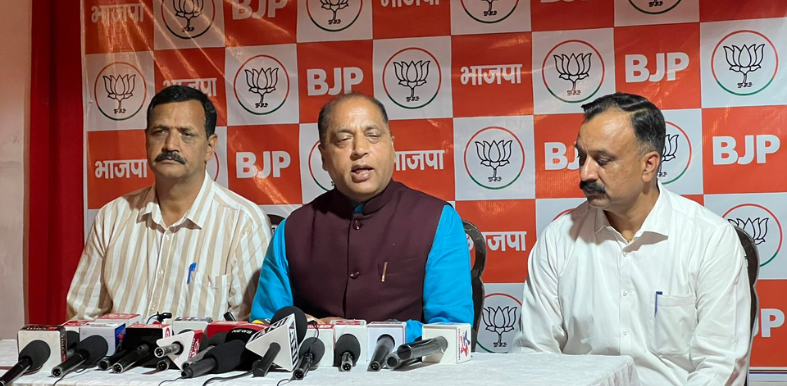Take sacred pledge to protect nature after monsoon fury
Munish Sood
MANDI:
Just weeks after flashfloods wreaked havoc across Himachal Pradesh, washing away homes, roads and livelihoods, a quiet but powerful movement rose in the Tirthan Valley.
At Dehuri in Kalwari panchayat of Banjar subdivision, villagers, officials, conservationists and artists gathered for the two-day Tirthan River Festival (September 21-22, 2025) — not merely to celebrate their culture, but to pledge their allegiance to the river that sustains their lives.
The festival came at a moment when Himachal is still counting the costs of the monsoon disaster. For many, the devastation was a stark reminder of what unchecked construction, deforestation, and exploitation of natural resources can trigger. In Tirthan, however, it became a turning point.
When rivers reclaim their space
“The floods were not God’s fury,” reflected Guman Singh, convener of Himalaya Niti Abhiyan, while addressing the gathering at the Great Himalayan National Park (GHNP) complex in Shairopa. “They were nature’s reminder that rivers need their space. If we keep encroaching, they will reclaim it.”
Others echoed the same sentiment. Varun Bharti, president of the Tirthan Conservation and Tourism Development Association, pointed to the garbage and plastic that had begun to choke the pristine river in recent years. “This festival is our way of saying sorry to the river,” he said. “Now we promise to protect it like our own mother.”
Sacred river with unbroken origins
Tirthan river, unlike many others in Himachal, remains untouched by hydropower projects. Originating from the holy Tirath Glacier at Hanskund within the Great Himalayan National Park, a UNESCO World Heritage Site, it flows pure and unbroken into the valley. Its sacred beginnings gave added weight to the festival’s theme: “Sustainability of Tirthan Valley and Conservation of Tirthan River.”
Local elder Ram Pyari, head of Adarsh Mahila Mandal-Dehuri, described the river as “the life-thread of the valley.” Standing by the water in traditional attire, she said: “We grew up drinking from this river, fishing in it, and praying to it. If we don’t protect it now, we will lose not just water, but our identity.”
Community comes together
The two-day event combined workshops, cultural programmes and traditional rituals. At Shairopa, experts from across Himachal and Delhi shared ideas on eco-tourism, waste management, and balancing livelihoods with ecology.
Dr Sandeep Minhas of the People for Himalayan Development (PHD) urged youth to “become guardians, not exploiters of the valley,” while retired fisheries officer Khem Singh Thakur explained how trout conservation could coexist with sustainable tourism.
But the most powerful moments came not from experts, but from ordinary villagers. In a symbolic ceremony on the riverbanks, men and women dressed in vibrant local attire, accompanied by the beats of dhol-nagada, offered prayers to the river. Together, they took a collective pledge:
“We, the people of Tirthan, promise to keep this sacred, life-giving river clean. We will not throw waste into it, we will not allow its misuse, and we will protect it for future generations.”
The festival blended tradition with awareness. From nati dance competitions to folk songs by rising singer Kamlesh Saraji and popular artist Shaina Thakur, performances carried subtle messages of environmental care. Street plays by the Sahara Kala Jatha highlighted how plastics and sewage were strangling mountain rivers.
“The idea was to make conservation fun and relatable,” explained Rajendra Chauhan, director of Sahara, one of the organising NGOs. “When people dance, sing, and laugh while learning, the message sticks.”
Children’s painting competitions and quiz sessions brought the younger generation into the fold, while local women participated in sports and group songs celebrating their bond with nature. Winners were felicitated by Lata Devi, chairperson of the Banjar Block Panchayat Samiti.
A free health camp organised by the health and Ayurveda departments added a practical touch, serving over 300 locals during the event.
Lessons for the state and beyond
Officials who attended acknowledged that the floods had changed the conversation in Himachal. Sub-Divisional Officer (Banjar) Pankaj Sharma admitted, “We cannot keep repeating the same mistakes. If communities are willing to step up, the administration must support them with strong policies against encroachment and pollution.”
The presence of deities from nearby villages — Lomash Rishi of Pekhri and Lakshmi Narayan of Kalwari — gave the festival a spiritual resonance. Their ceremonial meeting drew hundreds, reminding the crowd that in the Himalayas, nature and divinity have always been intertwined.





